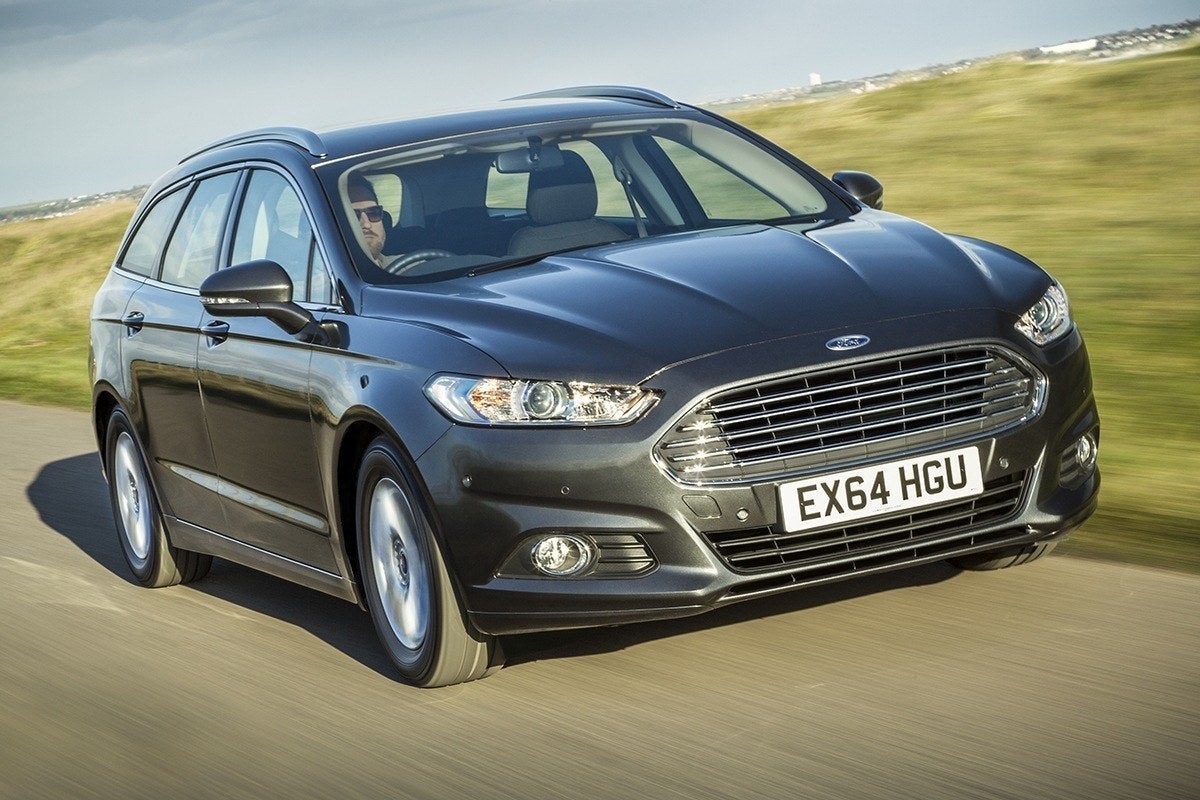Ford Mondeo Estate (2014-2022) Review
Written by Andrew Brady
Quick overview
Pros
- Comfortable ride
- Lots of passenger and boot space
- Safe family transport
Cons
- No longer on sale with no replacement due
- Cabin quality is disappointing
- Rivals can carry more stuff
Overall review on the 2014-2022 Ford Mondeo Estate
"Few cars have ended up so marooned by changing consumer tastes as the Ford Mondeo. Once it was so popular it could be used as shorthand to describe whole swathes of the population - now it's largely forgotten."
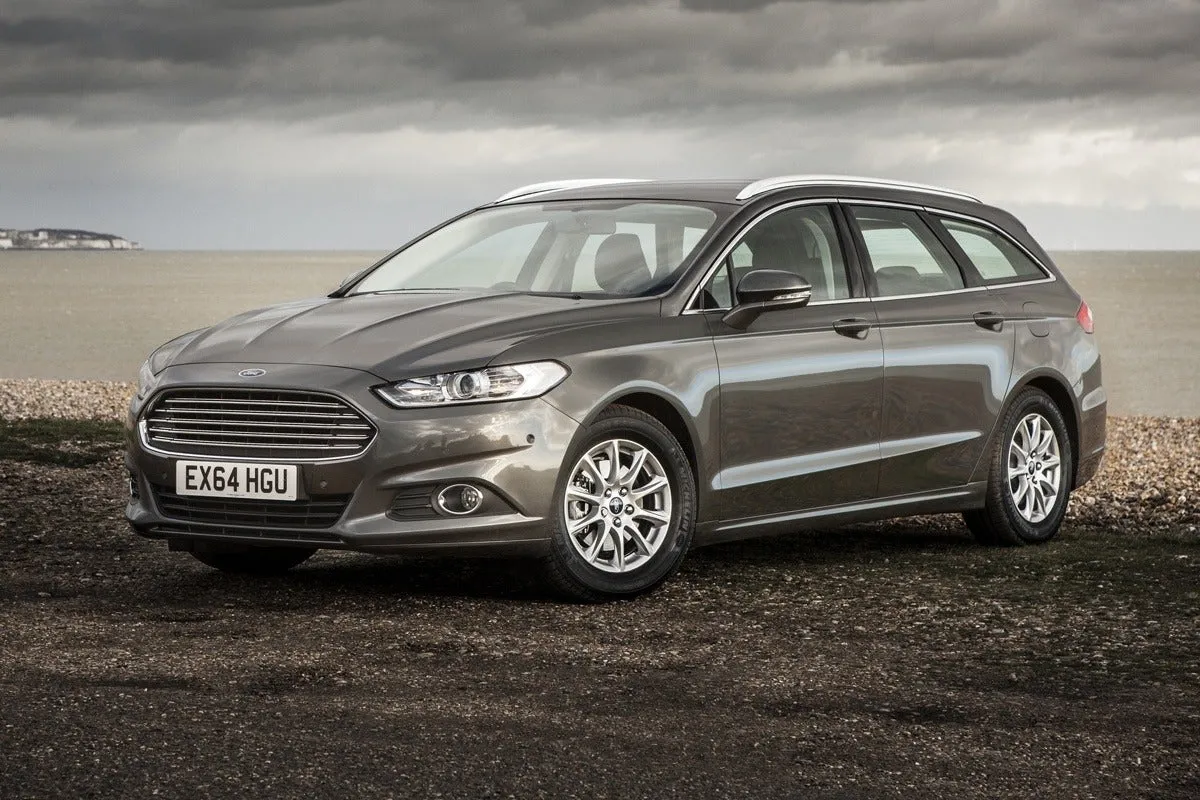
While SUVs have rocketed in popularity in recent years, estates have taken a back seat. Our Ford Mondeo Estate review details everything you need to know if you're looking for a well appointed family estate. Its humble image never held enough appeal for the image conscious, who would rather sacrifice the Ford's size and usability for a nicer badge on the bonnet.
Plenty of its rivals suffered a similar fate, with estate versions of the Vauxhall Insignia, Hyundai i40 and Kia Optima all quietly disappearing from showrooms to be replaced by crossovers of various shapes and sizes. As of 2022 the Ford Mondeo is not available to order new, and no replacement is in the pipeline, showing how quickly buyers shifted their focus to SUVs.
Ironically, the latest Ford Mondeo Estate was as good as ever, spacious and nice to drive, but no one wanted it. Ford was ill-equipped to take on this new breed of family car, or its premium competition, so after a valiant effort, and a facelift in 2019, the Mondeo Estate was reborn as an affordable, highly equipped budget option.
With new prices starting from £26,000 and used models trading hands for a fraction of that, it certainly nailed its brief. The Zetec trim comes with all the essentials, including sat-nav, and an 8.0-inch touchscreen with Android Auto and Apply Car Play connectivity, while mid-spec Titanium adds plush leather heated front seats.
Its boot is actually a bit smaller than in the five-door hatchback, but has a wide, deep loading bay that should offer more than enough volume for most families. Still, it can't hope to match the cavernous Skoda Superb. It has acres of passenger space, both in the front and the back seats, and can carry five adults without a fuss.
It's nice to drive, especially in its natural habitat hoovering up motorway miles. Its refined engines, cushioned ride and hushed interior make it a very relaxing cruiser. Avoid the stiffly sprung ST-Line cars, and you'll get a car that deals brilliantly with poor road surfaces, but can still tackle twists and turns in neat and tidy fashion.
Over the course of its life the Mondeo was offered with a lot of engines, from a 1.0-litre three-cylinder petrol to an 'ST' performance model with 240PS, but in 2020 Ford cut the range to a pair of diesels, and the hybrid. We're not sure of the wisdom of that decision, with most buyers migrating to petrol or plug-in hybrid models.
Still, the 2.0-litre diesel is a good one. It comes with either 150PS or 190PS, and the most powerful version has the option of four-wheel drive and a standard eight-speed automatic transmission. The cheaper model has a six-speed manual gearbox, which is a joy to use, and we definitely prefer it to the dim-witted automatic.
For most people, the low-powered diesel will be more than adequate. It's smooth, gutsy in gear thanks to a healthy slug of torque, and has fairly low running costs for such a big car. Petrol buyers need to buy used. The less said about the hybrid the better, but it would appear very low on our list of petrol-electric estates.
While the engine range has been modernised, the interior feels like it was left behind. A drab layout, plasticky materials and a dated infotainment system would be high on our list of reasons to give the Mondeo a miss. It has plenty of good qualities, but literally nothing exceptional to help it stand out in a crowded field of rivals.
Is the 2014-2022 Ford Mondeo Estate right for you?
Price-conscious buyers who want a big family car with relatively small running costs should consider getting a Ford Mondeo Estate. It's not the biggest or cleverest estate, but you do get a lot of car (and kit) for your money.
With such a narrow engine range, it'll really only suit buyers who do a lot of motorway miles, and can make good use of its impressive refinement, pliant suspension and reasonably parsimonious fuel economy figures.
The boot is actually a little smaller than on the hatchback with the seats in place, but you get a more useable load bay once they're folded, and passenger space is excellent. The so-so interior quality and dated media system mean it's easier to justify as a used car bargain, especially in top trims.
Make no mistake, this is a very pleasant car to do long journeys in, but its awkward size limits its usability in more congested settings. If you want a fuel-sipping hybrid, a wide range of plug-in rivals do a far better job too.
What's the best Ford Mondeo Estate model/engine to choose?
Simple is best in the Ford Mondeo Estate. Its temptingly low price is one of its most appealing qualities, so we would go for the one that gives the biggest bang for your buck. That's the 150PS 2.0-litre diesel in Zetec Edition trim.
Equipped with a slick manual gearbox, this engine is admirably refined, especially on the motorway. It's also punchy enough to haul you around even once you've got the car loaded to the rafters with people and stuff.
The spec list has everything you're likely to need, but if you're buying a used model then it’s worth searching out the Titanium or even Vignale version, as the leather seats and extra luxuries give the cabin a real boost.
Steer clear of the hybrid. It's pricey, not very efficient, gutless and noisy to drive on the motorway, and it has a much smaller boot than the standard car. It comes with far too many drawbacks to be a viable option.
What other cars are similar to the Ford Mondeo Estate?
Large family wagons with a similar footprint to the Ford Mondeo Estate but a larger boot include the Volkswagen Passat Estate and Skoda Superb Estate. These cars have nicer cabins and slicker on-board technology than the Ford can muster, a wider choice of engines, and while expensive, both are available as super efficient plug-in hybrids.
If you want a more affordable and less complicated hybrid, wrapped in a more manageably sized body, then the awkwardly named Toyota Corolla Touring Sports will fit the bill perfectly. In fact, plenty of estate cars that are technically from the class 'below' the Mondeo actually have more luggage capacity, and are cheaper too.
For those left underwhelmed by the Ford's dreary cabin, the Peugeot 508 SW has a stunning interior with smartly integrated infotainment, while the Mazda 6 Estate shows the Mondeo how to do classy minimalism.
With the exception of the Toyota, these cars are a little more expensive like-for-like, but we'd argue you'll be getting what you pay for. Investing in a nicer driving environment feels a worthwhile upgrade on cars like this.
Comfort and design: Ford Mondeo Estate interior
"Conservative design has been a traditional feature of cars like this for years, but the Ford Mondeo's cabin is plain to a fault. Most rivals have moved the game on by now. The simplicity of its design does make it easy to use."
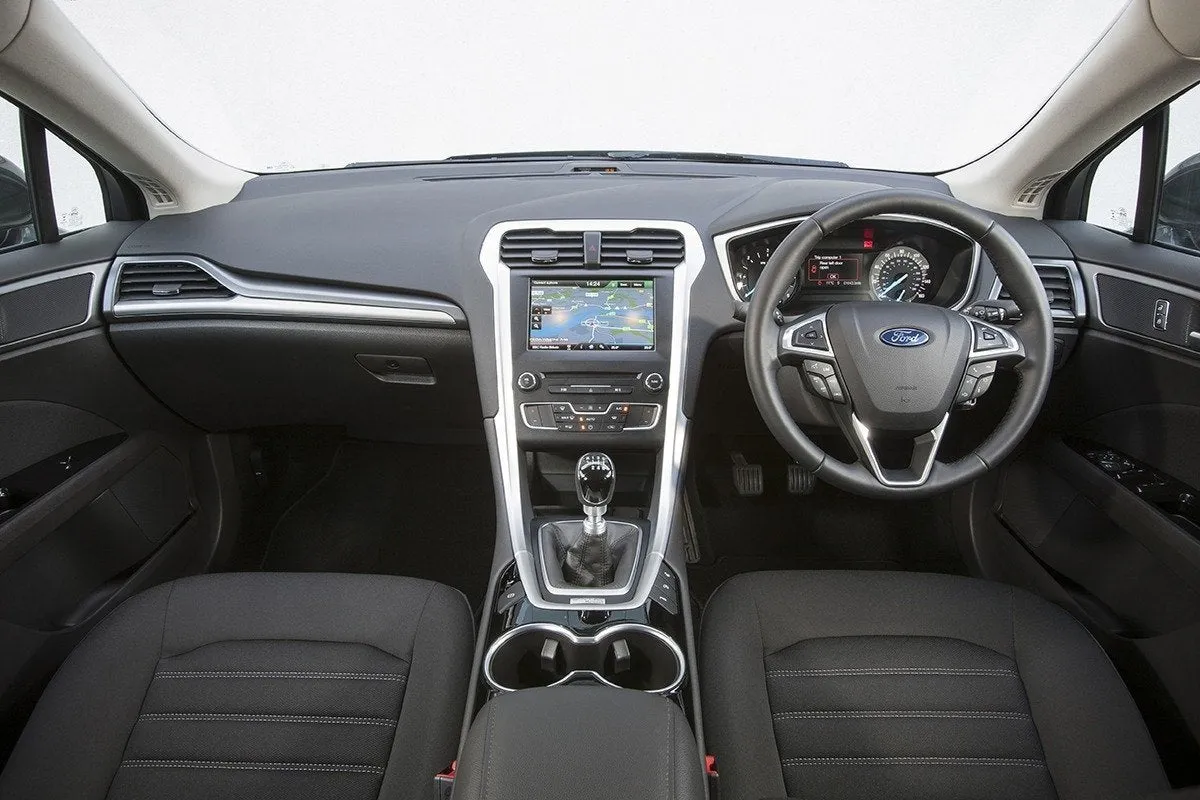
The centre stack is free of clutter, and the electronic handbrake keeps the space around the armrest clear. Of the controls that do feature, the climate switches are a little small, and you have to press them repeatedly to fine tune the temperature, where rivals provide dials that you can just twist to the right setting in a second.
You'll find four sets of rocker switches on the steering wheel, some of which are a bit fiddly to use while driving, but the dials (both the analogue and mixed digital set) are clear and very easy to read at a glance. Most of your interactions with the car will be through the 8.0-inch touchscreen, and we wish it was snappier.
The driving position gives us less to nit-pick. The pedals line-up nicely under the wheel, the standard seats are fairly supportive, and on all but the entry-level Zetec trim you get 10-way electric adjustment as standard.
The steering column comes out far enough to reach even very tall drivers, and the footwells are roomy, so its no hassle to prop up your left foot during long motorway stints. The windscreen is mounted far back from the driver, making it hard to judge where the bonnet ends, so we're very glad that parking sensors are standard.
Quality and finish
Ford has focussed on developing its SUV range, so stalwarts like the Mondeo have fallen by the wayside. Little time or money has been spent on updating a cabin that was passable in 2015, but now feels its age.
It's not budget in here by any means, but there isn't even a veneer or hint of premium quality in the materials. Everything you touch has a sturdy, workmanlike appearance that is functional, but the matte plastics are hard and scratchy. The Vauxhall Insignia estate feels like a major step up in fit and finish, let alone the Volkswagen Passat.
There is too much evidence of cost-cutting, like the flimsy boot liner and parcel shelf, and wide panel gaps in the doors that won't necessarily affect the day-to-day driving experience, but will be frustrating for those focused on the details.
As you travel up the range it starts to feel a bit posher, with leather seats, nicer carpet mats, bright metal pedals and on top-spec cars, extra leather coverings for the dashboard and doors. It's not enough to prevent the Ford Mondeo Estate being one of the least luxurious estates in its class, something we might struggle to forgive it for.
Infotainment: Touchscreen, USB, nav and stereo in the Ford Mondeo Estate
Ford developed its SYNC media system in partnership with software giants Microsoft, but if that gets your hopes up, then we'd quietly lower your expectations again. It's more Windows 98 in here than Xbox Series X.
As standard, every Ford Mondeo Estate comes with an 8.0-inch touchscreen in the centre of the dash, a built-in navigation system, DAB radio, Bluetooth, a pair of USB ports, eight speakers and basic voice commands.
That's a lengthy feature list, especially as it includes Android Auto and Apple Car Play connectivity, allowing you to simply plug in your phone and use all your navigation and music streaming apps while on the move.
So why aren't we satisfied? The hardware just feels hopelessly outmoded, especially compared with newer rivals such as the Skoda Superb Estate and ultra-futuristic Peugeot 508 SW. The touchscreen takes an age to respond to your inputs, the graphics are fuzzy and dated, and it's just not as intuitive as the best systems.
Titanium models get a large colour screen between the instruments, which displays driving and traffic sign information, plus basic route guidance, but it's not as slick or customisable as the full digital dials you'll find in the rivals we've mentioned above. The Vignale has a more powerful Sony Hi-Fi with 12 speakers that come as an option to lesser models, but booming sound quality is not our issue, and you can't upgrade the screen.
Space and practicality: Ford Mondeo Estate boot space
The Ford Mondeo hatch has one of the biggest boots in its class, so is it really worth paying more for the estate? We think so, as the flatter roof design improves headroom in the back, and it's even easier to load luggage.
That's because the loading bay is a wider, squarer shape than on the normal car, with no lip to negotiate, and a broader tailgate. It makes heaving awkwardly shaped items (like furniture) inside less of a wrestling match.
The Ford Mondeo Estate's boot capacity of 500 litres or 403 litres in the hybrid model is overly disappointing. It'll swallow the usual family items like several large suitcases, a stroller buggy or even a bike with its wheels on. No matter if the seats are up or down, though, it can't carry as much as either the Volkswagen Passat or Skoda Superb estates, so if you need every ounce of space, those cars will suit you better.
For most buyers though, it'll be capable enough to cope with family holidays or take a clear out to the tip. It's not especially flexible, but the rear seats split-fold 60:40 to maximise boot space to 1605 litres, and have a narrow ski hatch for longer loads.
Tall adults sitting in the front or back will have more than enough room to stretch out, and it’s so broad that even fitting three across the rear bench isn’t too much of a squeeze, despite its raised transmission tunnel.
Leg and shoulder room are generous, but anyone sat in the middle gets a flatter, less supportive seat than the passengers in the outer seats. You wouldn't want to sit there for hours on end, but it'll be find for shorter trips. Ford provides ISOFIX anchors for fitting a child seat, and the doors open far enough that they'll be easy to fit.
You'll find an assortment of useful storage cubbies dotted around the cabin. These include a decent glovebox with two sections, a deep compartment under the armrest, and even handy nooks behind the centre console.
In the hybrid, the batteries are clumsily stored in the boot, eating up value carrying space, and making the Mondeo fall even further behind its rivals. You can't tow with it either, just another reason to give it a miss.
The Mondeo Estate is a similar size to the saloon model at 4871mm long, 2121mm wide (with the mirrors out) and 1501mm tall.
Handling and ride quality: What is the Ford Mondeo Estate like to drive?
"There is a refreshing honesty to the way the Ford Mondeo drives. There are no adaptive dampers, or selectable driving modes, just conventional springs and dampers that have been properly setup for poor British roads."
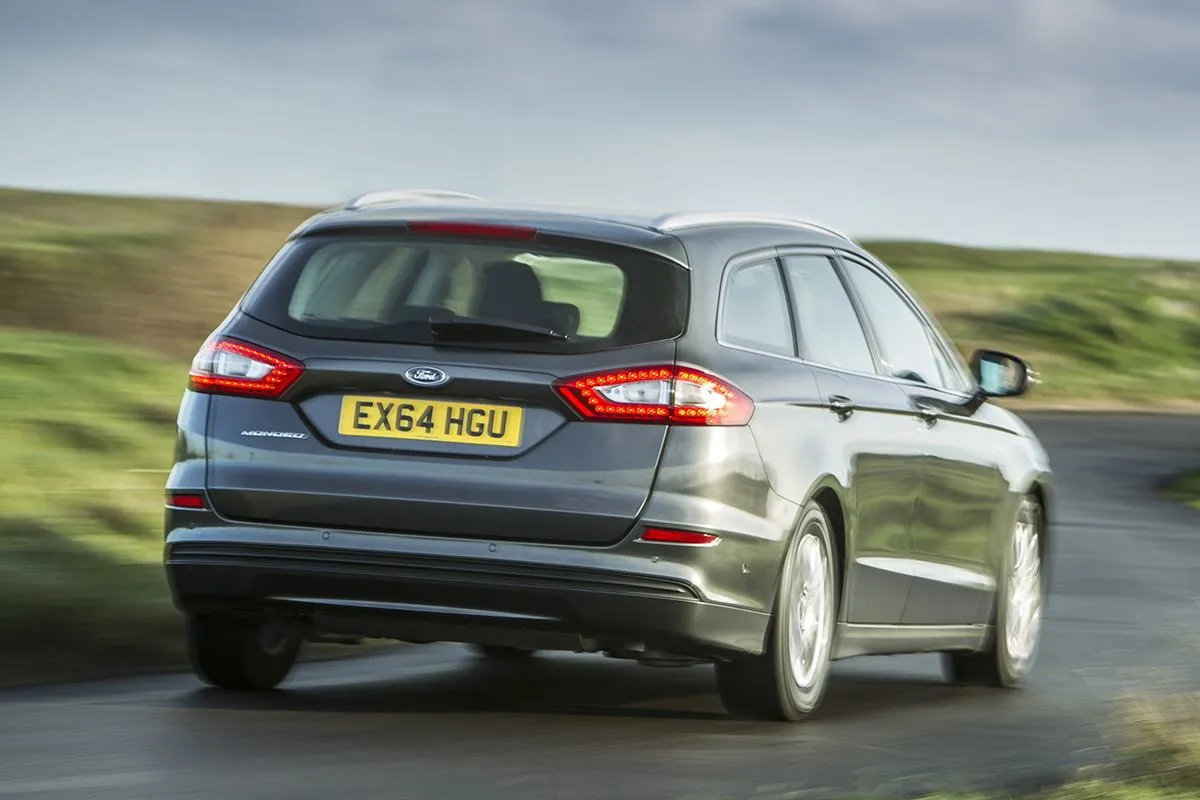
Ride comfort is pretty impressive. It'll isolate everyone on-board from any lumps and bumps it encounters with remarkable ease, shrugging off small imperfections in town, and settling into a soft, compliant cruise.
This supple nature doesn't come at the expense of body control either. It won't lean over in faster corners, or float over big compressions, which is great news if anyone in your family suffers badly from motion sickness.
The Mondeo has a reputation for being fun to drive, and that's still mostly the case. Its grippy and stable on winding roads, but the steering can feel too light, without a real sense of connection to the front wheels. We would stop short of calling it agile, as it's a large and heavy car but it is composed and the driving experience is free of any nasty surprises.
There are a few caveats though. ST-Line models (with their 19-inch wheels and stiffer sports suspension) do the plush ride no favours, feeling choppier than the standard models at low speeds. It stops short of feeling harsh, but copes poorly with the traffic calming measures that are now a common feature of most suburbs.
The featherweight steering is fine for weaving through traffic, but does take away some driver confidence on faster roads, and if you want to be engaged behind the wheel, a Mazda 6 Tourer is more fun to drive quickly.
On narrow country lanes, and even in supermarket car parks, the Ford Mondeo Estate feels big and cumbersome, and you'll find the long bonnet and rear bumper will be hanging out the end of parking spaces. As a result it can feel a bit intimidating to drive, especially since the visibility is not as good as it would be in a raised-up SUV.
What engines and gearboxes are available in the Ford Mondeo Estate?
Buyers like choice. Whether you're shopping for a new shirt or a new home, being able to pick and choose from a range of options helps us make informed decisions that fit our personal circumstances more closely.
Ford knows this, and the Ford Mondeo Estate used to be available with a broad selection of engines to suit all budgets. However, the brand has had its hands tied by stricter emissions regulations and a sharp decline in demand, so the only two options for towards the end of its life were either a 2.0-litre diesel, or a petrol-electric hybrid model.
The former does come in two states of tune. As standard it produces 150PS and 350Nm and pairs up with a six-speed manual that sends power through the front wheels. It's not particularly quick, but there is plenty of low-down oomph when you do need it to get a shift on. Better yet, it's the most efficient model in the line-up.
To be honest, most will struggle to notice the extra 40PS and 50Nm in the higher-powered model in everyday driving. It doesn't feel brawnier in-gear, and its performance and economy are blunted by its automatic 'box.
It has eight forward speeds, but takes its time picking between them, with an irritating tendency to hesitate. Unless your driving routine regularly involves a lot of bumper-to-bumper traffic jams, we'd pick the manual.
Previously, you could get a 1.5-litre petrol that was refined but not especially economical, while earlier cars even came with the 125PS 1.0-litre three-cylinder from a Ford Fiesta, which struggled a bit with the estate's bulk. The former might see you visiting the pumps more often, but was a good alternative for low mileage drivers.
There is no real reason to buy the hybrid. It feels weedy when fully laden with passengers, is noisy when accelerating thanks to its CVT transmission, and isn't even that efficient compared with the entry-level diesel. Toyota's Corolla estate is cheaper, cleaner and quieter, while the Volkswagen Passat GTE has vastly better economy.
Refinement and noise levels
This is an area where the Ford Mondeo Estate really impresses. It's quieter on the motorway than many premium cars, with very little wind or engine noise, and just a distance hum from the tyres on sensibly-sized wheels.
Its 2.0-litre diesel engine is very civilised, with long gearing in the six-speed gearbox keeping the revs under control. It's a tad gruff when cold, but quickly fades into the background once you get it up to speed. Its gutsy performance also means you don't need to work it too hard to gain momentum, making it a relaxed cruiser.
The discontinued 1.5-litre petrol is even quieter in town, but requires a little encouragement to get it moving, especially fully laden with passengers. The pleasant growl it emits when worked is never intrusive though.
You won't feel any unwelcome vibrations coming through the steering wheel rim or pedals, but if you want a quiet life, it would be best to avoid the hybrid model. It features a CVT automatic gearbox that (as typifies this kind of transmission) blares out a constant drone when you want it to accelerate, without going any quicker.
The six-speed manual in the 150PS diesel is precise, with a long but accurate throw. Moving smoothly up the gears is no hardship, and the clutch is fairly light. Things are less rosy in the automatic. It has a tendency to hunt for the right gear, pausing between its shifts and shunting as it engages. This upsets the tranquility a bit.
Safety equipment: How safe is the Ford Mondeo Estate?
The Ford Mondeo Estate is one of the safest estate cars on the market, courtesy of some changes made to its spec list after the facelift, which added improved safety assistance to go with the Mondeo's impressive standard kit.
It can help you avoid getting into snafus too, with automatic emergency braking standard across the range. Using a forward-facing camera it detect cars, cyclists and pedestrians in your path, and if the car senses a collision is imminent, it'll alert the driver with a visual warning, bringing the car to a full stop if you don't react.
On older Mondeos, you had to step up to Titanium trim to get useful active systems such as lane departure warning and traffic sign recognition, which pops the current speed limit up inside the digital driver's display. These features are now standard across the range, along with tyre pressure monitors, cruise control with a speed limiter, a full complement of airbags, and front and rear acoustic sensors to help you park up.
The latest and pre-facelift models both earned a full five-star rating from safety body Euro NCAP, but the latter underwent an easier crash testing regime, while the newer car has kept up with the latest standards. To give you an idea of just how safe, it matches the premium Volvo V60 for adult crash protection, bettering the Swedish car for child protection, matching it step-for-step in the pedestrian and assistance categories.
Buyers who want a few additional electronic safety aids should specify the optional Driver Assistance Pack. It's only available on Titanium models and above, but includes an automatic parking aid that will do all the steering inputs for you, blind spot monitors, a rear-view camera, and adaptive radar-guided cruise control.
MPG and fuel costs: What does a Ford Mondeo Estate cost to run?
"Pick any of the diesels if you want to travel long distances. Expect to achieve just under 50mpg on a cruise, slightly below the claimed WLTP figures of 53.3mpg for the 150PS Zetec model fitted with a manual gearbox. "
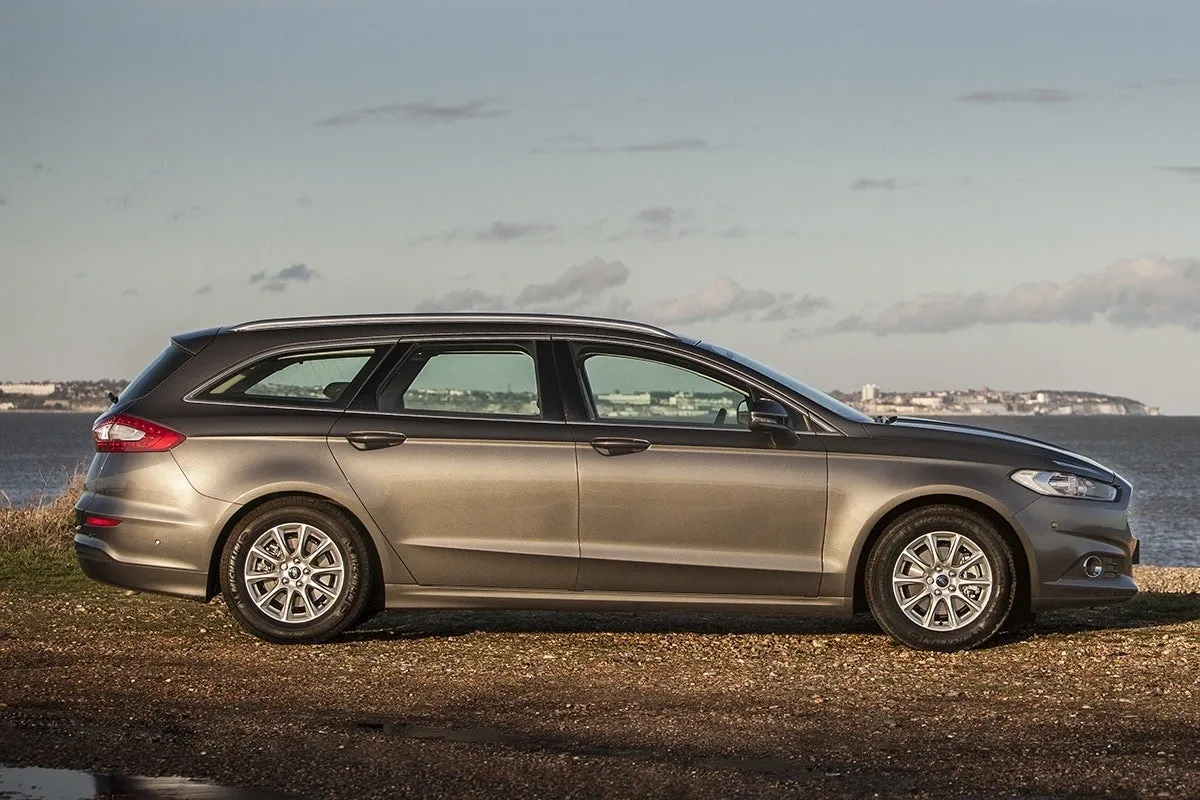
As you move up the range, the larger wheels, heavier equipment, higher power outputs and (on some cars) four-wheel drive system all increase fuel consumption, but even the thirstiest cars should get over 40mpg.
With a larger fuel tank on all-wheel drive Ford Mondeos, you should be able to get from London to Aberdeen on a single tank of diesel, with front-wheel drive cars able to turn around and go back down to Dundee afterwards. You might be thinking, what about the hybrid? Well, despite its second-generation petrol-electric powertrain, it can't match the frugal diesels. Since it's not a plug-in, there's no zero emissions driving to be had either.
True, you won't have to stick the Ford Mondeo Estate into a socket after every journey, but the Toyota Corolla Touring Sports uses the same conventional hybrid hardware, yet it manages close to 60mpg and 112g/km.
How reliable is the Ford Mondeo Estate?
Ford came 26th out of 30 manufacturers with 85.8% on the latest HonestJohn.co.uk Satisfaction Index. The Ford Fiesta featured on the top 20 cars and worst 20 cars, the latest generation in the top, whilst the previous generation ranked as the least reliable car in the survey. Newer Mondeo Estates should follow suit and prove to be more reliable.
Insurance groups and costs
The Ford Mondeo proves that insuring a large car doesn't have to cost the earth, but there's a split between the older model and the facelift. Earlier cars fitted with the smaller petrol engines start from as low as Group 15.
Popular 1.5-litre diesels from the same year start from two groups higher, but because the current line-up is comprised of larger, more powerful engines, they'll increase your annual premiums. The cheapest to cover is the hybrid - in Group 21 - while the 2.0-litre diesel models kick-off in Group 23 and go right up to Group 29.
That's still not as affordable as mainstream rivals from Skoda and Vauxhall, but is certainly less than you'll need to cough up for a premium estate. It also undercuts closer peers like the Mazda 6 Tourer and Peugeot 508 SW.
VED car tax: What is the annual road tax on a Ford Mondeo Estate?
The tax you'll pay on your Ford Mondeo Estate will vary depending on its age. Even the priciest version costs less than £40,000 new, so unless you add every single option, you'll avoid paying the higher premium VED rate.
Instead, cars registered after 1st April 2017 pay the standard rate, currently £165 for petrols and diesels, with a measly £10 alternative fuels discount on top of that for the hybrid model. Hardly a massive buying incentive.
Older models registered prior to this date will be significantly cheaper, since their road tax is calculated from NEDC CO2 emissions. That means the cleanest diesels will set you back less than £30 a year, and in some cases will be completely exempt, although the most polluting 2.0-litre petrol turbo is a more onerous £265.
For company drivers, the hybrid estate attracts the lowest BIK rate of 29% but that's nowhere near the 10% rate you'll pay for sophisticated plug-in hybrid rivals such as the Volkswagen Passat GTE and Peugeot 508 SW PHEV.
How much should you be paying for a used Ford Mondeo Estate?
"If you're buying new, the roomier estate commands roughly a £1500 price premium over the standard car. It loses that advantage on the used market though, with prices in-line with what you'll pay for the five-door."
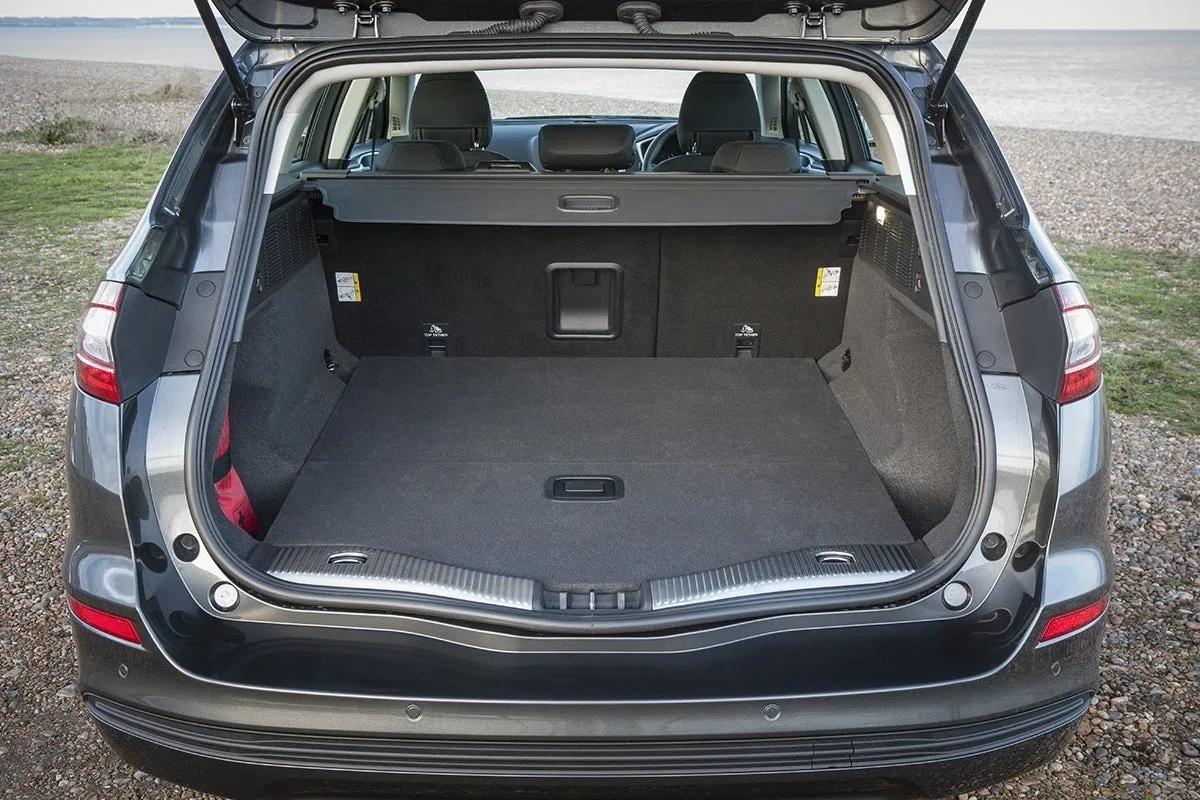
Between £12,000 and £14,000 you'll find cars from 2016 with under 70,000 miles. There's some examples in the same price range that are slightly newer with higher mileage, but still under 100,000 miles.
To secure a car with average yearly mileage (so around 60,000 in total) in much better condition and a wider range of trims, you'll need to push your budget up to over £15,000. Most examples at this price will feature one of the frugal smaller diesel engines, paired with a manual gearbox, in Zetec or Titanium specification.
Used values for petrol models are much stronger. You'll need at least £18,000 to get behind the wheel of any of the 1.5-litre Ecoboost turbocharged models, and the majority are equipped with an automatic gearbox.
Trim levels and standard equipment
There is nothing mystifying or complicated about the Ford Mondeo Estate, and that includes its equipment list. Stump up for the entry-level Zetec Edition and it's anything but basic, while the high-spec models get loads of gadgets.
On pre-facelift models there was a more basic trim called Ford Mondeo Estate 'Style' but now every model comes with everything you would want from a large family car, with climate and cruise control, all-round parking sensors, a heated windscreen, plus an 8.0-inch touchscreen media system featuring sat-nav, DAB, and Bluetooth connectivity.
It looks relatively smart on the outside too, with black roof rails, 17-inch alloy wheels, fog lights, keyless start, LED running lights and a few dash of chrome. Mid-spec Ford Mondeo Estate Titanium models have a kit list that would turn some premium buyers green with envy, featuring 18-inch wheels, a 10-inch colour driver's display within the dials, and full leather, electrically adjustable front seats that are heated too, LED cabin lighting and keyless entry.
We think the Ford Mondeo Estate Zetec makes the most financial sense, especially for buyers looking for a good deal, but if you can find a Titanium with a decent discount or used, its luxurious touches do help lift the dreary interior a bit.
Ford Mondeo Estate ST-Line spec is the sporty spice of the line-up, with a subtle bodykit, lowered suspension, red brakes, and a bespoke grille design. Inside, you get body-hugging seats, racy red stitching in the leather trim and attractive metal finished pedals, plus a dark headliner to make you feel more cocooned on the inside.
Ford would like you to think of the range-topping Ford Mondeo Estate Vignale as a separate model that competes with premium estates from Audi and BMW, but that billing feels like a bridge too far for the Mondeo. Spec highlights include heated and cooled massage seats, extra leather on the dashboard, LED headlights and a rear-view camera.
Since the spec list is so generous, the options list is only a couple of pages in the brochure, and unlike many brands, it's possible to cherry-pick key features you want from pricier models, and add them to lower trims. If you're buying a Zetec get the Winter Pack. It adds toasty heaters to the steering wheel, front and rear seats.
Ask the heycar experts: common questions
Are Ford Mondeo Estates reliable?
What is the top of the range Mondeo?
Why is Ford discontinuing the Mondeo?
Get our latest advice, news and offers
Keep me updated by email with the latest advice, news and offers from heycar.
By submitting you agree to our privacy policy
